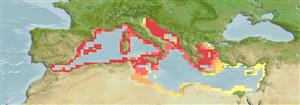Common names from other countries
Environment: milieu / climate zone / depth range / distribution range
Οικολογία
; εύρος βάθους 0 - 123 m (Ref. 85345). Subtropical
Atlantic and the Mediterranean Sea: Turkey and Algeria.
Length at first maturity / Μέγεθος / Βάρος / Age
Maturity: Lm ? range ? - ? cm Max length : 30.0 cm TL αρσενικό/απροσδιόριστο; (Ref. 363); μεγ. δημοσιευμένο βάρος: 340.00 g (Ref. 363)
Maximum size: 25 cm (Ref. 358); approximately 30 cm. maximum width: 6 cm. Average weight: 340 g (Ref. 363). Body: with more or less round cross section; is provided with the ventral face with 3 lines with parapodes with suction cup. Tegument: comprises many papillae of sunk color, prolonged by a final silk of dark color; resistant in the majority of the cases and is very seldom thin. Variable coloring of the red with nuance of brown which some time draws on the purple one. The animal is deprived of tubes of Vat (Ref. 358).
Maximum size: 25 cm (Ref. 358); approximately 30 cm (Ref. 363). Method: Captured with the hand, with dredgers and trawls basic, and probably used like food in some countries. Fisheries: Probably one of the species which Turkey exports in Japan (Ref. 363). Habitat: Sandy rich person funds muddy out of organic remains, or on hard substrates forks and spoons of plants. Present at all depths, the species is very common, even locally very abundant, but does not seem not represented in the sectors western and southern of the basin. Biology: the tubules sea cucumber nourishes various organic fragments, (charging) literally the elements of the ground in its oral opening, located at the back of the body, using its tentacles oral of flattened form. The animal sorts and introduces the edible organic substances, and rejects the elements not metabolize, particularly sand, in the form of lengthened excrements (Ref. 358). Habitat: Very common benthic species, approximately presents littoral zone up to 100 m of depth, on the rock funds covered with algae, the meadows of Posidonia and other Phanérogames, sand and the mud. It is said that it moves at the speed of one meter every 10 minutes. Very often shelter fish of the Carapus kind. Eviscerate easily when it is disturbed (Ref. 363). Occurs at the low tide mark.
Life cycle and mating behavior
Γεννητική Ωρίμανση | Αναπαραγωγή | Γεννοβολία | Αβγά | Γονιμότητα | Προνύμφες
A migration towards surface waters occurs, especially at the end of the summer, at the end which the expenses are easily recognizable, since one sees them vertically drawing up the 2/3 of their body and expelling their gametes in the form of fine clouds in the surrounding medium (Ref. 358).
Göthel, H. 1992. (Ref. 358)
IUCN Red List Status (Ref. 130435)
CITES status (Ref. 108899)
Not Evaluated
Not Evaluated
Human uses
αλιεία: Εμπορικό(ά)
| FishSource |
Εργαλεία
Διαδικτυακές πηγές
Estimates based on models
Preferred temperature
(Ref.
115969): 14.1 - 20.9, mean 18.1 (based on 174 cells).
Ελαστικότητα
Υψηλό, ελάχιστος χρόνος για διπλασιασμό πληθυσμού < 15 μήνες (K=0.66).
Vulnerability
Low vulnerability (20 of 100).
Price category
Unknown.
